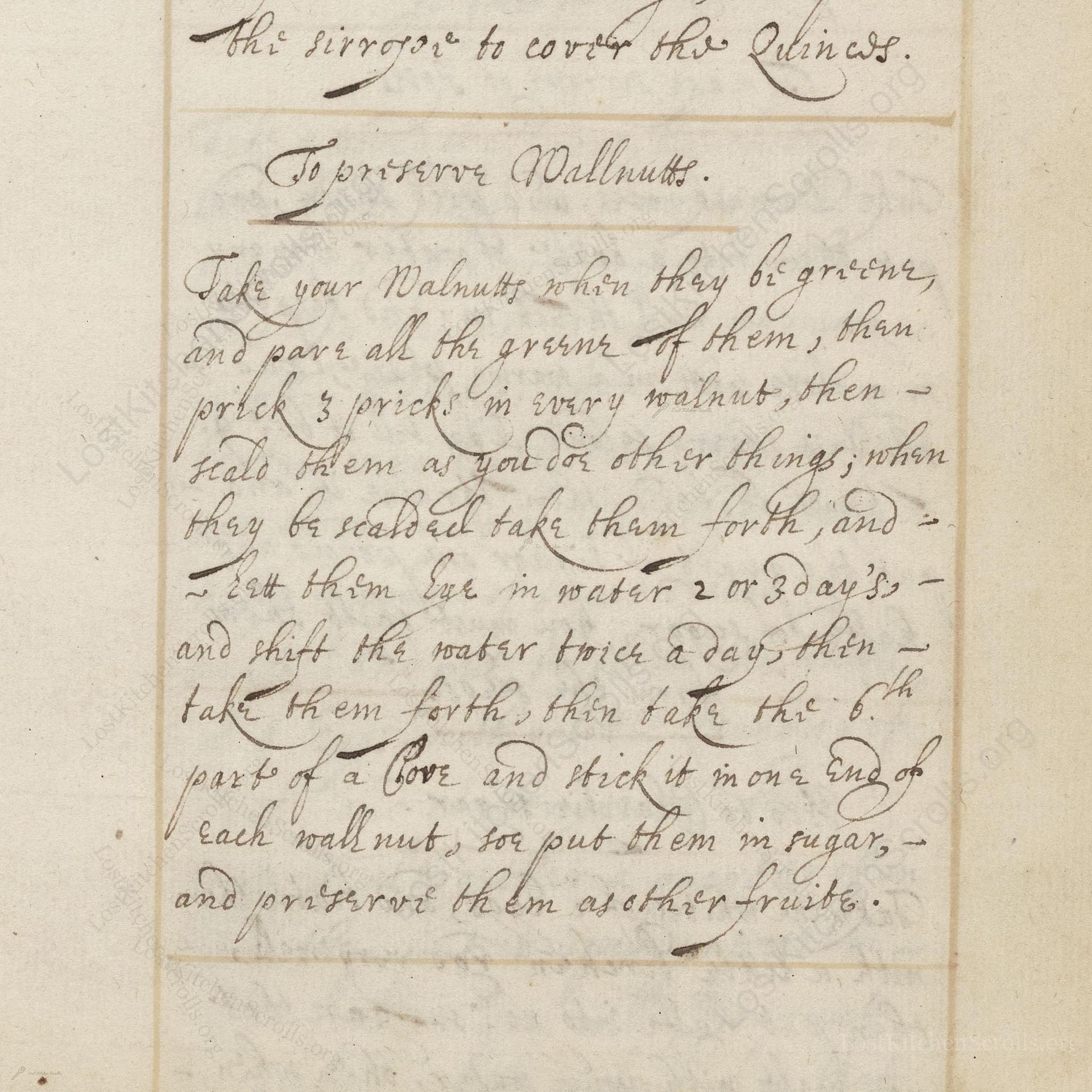To Preserrve Walnutts
From the treasured pages of Receipt book of Sarah Longe
Written by Sarah Longe

To Preserrve Walnutts
"Take your Walnutts when they be greene, and pare all the greene of them; then prick 3 pricks in evry wallnutt; then - scald them as you do other things; when they be scalded, take them forth, and - lett them lye in water 2 or 3 day's; - and shift the water twice or 3 day's; then - take them forth, then take the 6th - part of a love and strick it in one End of Each wall nutt, sor put them in sugar, - and preserrve them as other fruite."
Note on the Original Text
The recipe's language is typical for the early 1600s, written in loose prose without exact measurements or times, relying on the cook's intuition. Spelling was fluid: 'preserrve' instead of 'preserve,' 'wallnutt' for 'walnut,' and 'love' likely referring to 'clove' (the spice). Instructions like 'scald them as you do other things' hint at assumed culinary knowledge—scrupulously left unelaborated.

Title
Receipt book of Sarah Longe (1610)
You can also click the book image above to peruse the original tome
Writer
Sarah Longe
Era
1610
Publisher
Unknown
Background
A delightful glimpse into early 17th-century kitchens, this collection by Sarah Longe whisks readers through ancestral recipes, cooking tips, and the seasonings that graced the tables of Jacobean England. Prepare to savor the tastes and traditions of times gone by.
Kindly made available by
Folger Shakespeare Library
This recipe comes from Sarah Longe's manuscript, dated around 1610—a time when home preservation was essential for making the most of the harvest. Preserved walnuts were a delicacy, often enjoyed as sweetmeats or used to accompany meats and cheeses at the dining tables of the English gentry. Green (unripe) walnuts were a prized seasonal ingredient, and the method reflects both the necessity to preserve perishables before refrigeration and England's growing interest in sweet, spiced preserves influenced by global trade.

In the early 17th century, the cook would have used a small, sharp knife for peeling, a fine needle or thin awl for pricking, and a large kettle or cauldron for boiling water. Earthenware or wooden bowls provided soaking containers. The preserved walnuts would have been stored in glazed ceramic jars or stoneware.
Prep Time
40 mins
Cook Time
10 mins
Servings
10
We've done our best to adapt this historical recipe for modern kitchens, but some details may still need refinement. We warmly welcome feedback from fellow cooks and culinary historians — your insights support the entire community!
Ingredients
- 1 lb fresh green walnuts (soft, unripe)
- Water, as needed for soaking and blanching
- 6-10 whole cloves (Syzygium aromaticum), or 1 per walnut divided into sixths
- 1 1/2 to 2 cups granulated sugar (as needed for coating or making syrup)
Instructions
- Take fresh green walnuts, ideally when soft enough to pierce with a needle—usually harvested in late spring or early summer.
- Using a vegetable peeler, remove all the green outer husk.
- Prick each walnut three times with a sharp skewer or needle.
- Bring a pot of water to a boil and blanch the walnuts for a few minutes, similar to scalding fruits before preserving.
- Remove and submerge them in fresh cold water.
- Leave the walnuts soaking for 2-3 days, changing the water twice a day to reduce bitterness.
- When ready, remove the walnuts and dry them a bit.
- Then, take about one-sixth of a clove (most likely clove spice) and stick one piece into the end of each walnut.
- Place the walnuts in a preserving jar or container, cover with sugar (enough to coat or possibly a basic syrup to submerge), and preserve as you would candied fruit, allowing them to steep and absorb sweetness.
Estimated Calories
110 per serving
Cooking Estimates
Preparing these candied green walnuts involves peeling, pricking, blanching, soaking, spicing, and packing them with sugar. Soaking takes the most time, but actual hands-on work is much shorter. Each walnut is considered one serving, and calories will depend on the amount of sugar used.
As noted above, we have made our best effort to translate and adapt this historical recipe for modern kitchens, taking into account ingredients nowadays, cooking techniques, measurements, and so on. However, historical recipes often contain assumptions that require interpretation.
We'd love for anyone to help improve these adaptations. Community contributions are highly welcome. If you have suggestions, corrections, or cooking tips based on your experience with this recipe, please share them below.
Join the Discussion
Rate This Recipe
Dietary Preference
Main Ingredients

Den Bockfisch In Einer Fleisch Suppen Zu Kochen
This recipe hails from a German manuscript cookbook compiled in 1696, a time whe...

Die Grieß Nudlen Zumachen
This recipe comes from a rather mysterious manuscript cookbook, penned anonymous...

Ein Boudain
This recipe comes from an anonymous German-language manuscript cookbook from 169...

Ein Gesaltzen Citroni
This recipe, dating from 1696, comes from an extensive anonymous German cookbook...
Browse our complete collection of time-honored recipes



